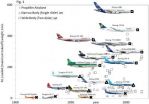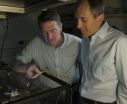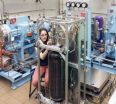(Press-News.org) WASHINGTON D.C. July 22, 2014 -- One of the traditional arguments against Darwinian evolution has been that no one can confirm the process exists because it occurs on a time scale immensely greater than a human lifetime. Adrian Bejan, the J. A. Jones Distinguished Professor of Mechanical Engineering at Duke University, has disagreed with that notion ever since 1996 when he discovered the Constructal Law, a fundamental principle of physics that underlies the evolution of flow systems as they change in design over time.
In a new paper in the Journal of Applied Physics, from AIP Publishing, Bejan and colleagues apply this now-famous law to airplanes, showing, as he said, "that we can witness evolution in our lifetime by documenting the evolution of a flow system that is a little more than a century old: the flying 'human-and-machine species'.
For nearly two decades, Bejan has used the Constructal Law to show how each and every "tree-like" flow pattern, whether natural and manmade -- e.g., rivers and basins, neural networks, lightning bolts, electrical circuitry, and of course, trees themselves -- could all be linked in terms of how they change in design over time to maximize function. "Simply put," Bejan said, "the Constructal Law states that for any finite-size flow system to persist, that is, be alive, it must evolve in such a way that it provides easier and easier access to its currents."
In the Journal of Applied Physics paper, Bejan and colleagues examined aircraft designs dating to the beginning of manned flight. They noted that, like the flyers in nature (e.g, birds, bats, insects) throughout "Big History" (history from the Big Bang to the present), the evolutionary trend has been toward larger and larger size. "We showed that larger airplanes are faster, more efficient as vehicles, and have greater range," Bejan said. "Engine mass is proportional to body mass, a design feature that is the same in animals where the mass of the motive organs -- muscle, heart and lungs -- is proportional to body mass."
The researchers also showed that large or small, airplanes exhibit proportionality between wing span and fuselage length, and also between fuel load and body size. "This again is akin to what we see among the flying creatures in nature, showing that airplanes converge the architectural design rules that unite them with their living counterparts," Bejan said.
Because the data in the latest study show that airplane design has followed an evolutionary path dictated by the Constructal Law, Bejan believes that it should be easy to predict the next stages. "Armies of aerospace designers," he said, "are pushing the envelope, but guess what? The broad view of the future, which can now be predicted with the law of design in nature, says that new lines of aircraft will emerge along the lines discovered here."
Bejan said that he hopes the new paper will help "demystify" evolution by showing it applies to everything, natural and manmade -- and that "it is much broader than just biological evolution, and definitely belongs in physics."
INFORMATION:
The article, "The Evolution of Airplanes," is authored by A. Bejan, J.D. Charles and S. Lorente. It will appear in the Journal of Applied Physics on July 22, 2014. After that date, it can be accessed at: http://scitation.aip.org/content/aip/journal/jap/116/4/10.1063/1.4886855
ABOUT THE JOURNAL
Journal of Applied Physics is an influential international journal publishing significant new experimental and theoretical results of applied physics research. See: http://jap.aip.org
The evolution of airplanes
Analysis in the Journal of Applied Physics uses 'constructal law' to witness the evolution of airplane designs over time and predict the future of aerospace design
2014-07-22
ELSE PRESS RELEASES FROM THIS DATE:
Bats use polarized light to navigate
2014-07-22
Scientists have discovered that greater mouse-eared bats use polarisation patterns in the sky to navigate – the first mammal that's known to do this.
The bats use the way the Sun's light is scattered in the atmosphere at sunset to calibrate their internal magnetic compass, which helps them to fly in the right direction, a study published in Nature Communications has shown.
Despite this breakthrough, researchers have no idea how they manage to detect polarised light.
'We know that other animals use polarisation patterns in the sky, and we have at least some idea ...
'Comb on a chip' powers new NIST/Caltech atomic clock design
2014-07-22
Researchers from the National Institute of Standards and Technology (NIST) and California Institute of Technology (Caltech) have demonstrated a new design for an atomic clock that is based on a chip-scale frequency comb, or a microcomb.
The microcomb clock, featured on the cover of the inaugural issue of the new journal Optica,* is the first demonstration of all-optical control of the microcomb, and its accurate conversion of optical frequencies to lower microwave frequencies. (Optical frequencies are too high to count;microwave frequencies can be counted with electronics.)
The ...
Mount Sinai scientists and international team shed new light on schizophrenia
2014-07-22
NEW YORK, NY -- As part of a multinational, collaborative effort, researchers from the Icahn School of Medicine at Mount Sinai have helped identify over 100 locations in the human genome associated with the risk of developing schizophrenia, in the largest genomic study published on any psychiatric disorder to date, conducted with 80,000 people. The findings, published online in Nature, point to biological mechanisms and pathways that may underlie schizophrenia, and could lead to new approaches to treating the disorder, which has seen little innovation in drug development ...
P90X? Why consumers choose high-effort products
2014-07-22
Stuck in traffic? On hold for what seems like an eternity? Consumers often face situations that undermine their feelings of control. According to a new study in the Journal of Consumer Research, when a person's sense of control is threatened, they are more likely to seek out products that require hard work.
"Intuitively, it would seem that feeling a loss of control might cause consumers to seek out a product that does NOT require them to exert very much effort. But we find that consumers actually look to products that require hard work to restore their belief that they ...
Fill 'er up: NIST develops prototype meter test for hydrogen refueling stations
2014-07-22
To support the fair sale of gaseous hydrogen as a vehicle fuel, researchers at the National Institute of Standards and Technology (NIST) have developed a prototype field test standard to test the accuracy of hydrogen fuel dispensers. Once the standard is field tested, it will serve as a model for constructing similar devices for state weights and measures inspectors to use.
Three automakers plan to begin selling hydrogen-fueled vehicles to consumers in 2015. The state of California has opened nine refueling stations and is funding the construction of an additional 28 ...
Overdoing it: Multiple perspectives confuse consumers
2014-07-22
Television commercials for luxury vehicles pack a lot in their 30-second running times: the camera offers quick shots of the soft leather upholstery, the shiny colors, the state-of-the-art entertainment system, and the four-wheel drive. But these multiple angles and shifting perspectives have a negative impact on consumer evaluation of products, according to a new study from a Tel Aviv University researcher.
TAU's Dr. Yael Steinhart and her collaborators Yuwei Jiang of Hong Kong Polytechnic University, Rashmi Adaval of Hong Kong University of Science and Technology, and ...
Why do challenging tasks make consumers believe drugs wear off faster?
2014-07-22
Imagine that you have a cup of coffee and sit down to read People magazine. How long do you think the energy boost will last before you reach for another cup? Would you need more caffeine if you tried to read War and Peace? A new study in the Journal of Consumer Research finds that consumers wrongly believe that pharmacological products such as coffee and aspirin lose their effectiveness when they engage in more strenuous activities.
"People make assumptions about how long it takes for products to wear off. For example, they know that cars burn gasoline more quickly ...
Empathy or justice: What makes consumers donate more to charity?
2014-07-22
Have you ever received a request for help and wondered how deserving the recipients are of your donation? This way of thinking may seem inconsistent with your moral values, especially if you consider yourself an otherwise compassionate and empathic person. A new study in the Journal of Consumer Research suggests that moral identity decreases donations when recipients are deemed to be responsible for their plight.
"Our research examines how moral values of empathy and justice have distinct influences on people when they are asked to make donations benefiting others whose ...
I'll have what he's having? How consumers make choices about new products
2014-07-22
Have you found yourself at a fancy restaurant trying to impress new friends or in a foreign country and unsure of what to order? Not wanting to appear foolish, you just go along with everyone else. According to a new study in the Journal of Consumer Research, we're more likely to copy other people's choices when we lack social acceptance or enough information to make an informed decision.
"We suggest that when someone is deciding between options for which their preferences are not well formed, observing the choice of another consumer makes the option chosen by the other ...
Quantum leap in lasers at Dartmouth brightens future for quantum computing
2014-07-22
Dartmouth scientists and their colleagues have devised a breakthrough laser that uses a single artificial atom to generate and emit particles of light. The laser may play a crucial role in the development of quantum computers, which are predicted to eventually outperform today's most powerful supercomputers.
The study appears in the journal Physical Review B.
The new laser is the first to rely exclusively on superconducting electron pairs. "The fact that we use only superconducting pairs is what makes our work so significant," says Alex Rimberg, a professor of physics ...
LAST 30 PRESS RELEASES:
New study reveals 33% gap in transplant access for UK’s poorest children
Dysregulated epigenetic memory in early embryos offers new clues to the inheritance of polycystic ovary syndrome (PCOS)
IVF and IUI pregnancy rates remain stable across Europe, despite an increasing uptake of single embryo transfer
It takes a village: Chimpanzee babies do better when their moms have social connections
From lab to market: how renewable polymers could transform medicine
Striking increase in obesity observed among youth between 2011 and 2023
No evidence that medications trigger microscopic colitis in older adults
NYUAD researchers find link between brain growth and mental health disorders
Aging-related inflammation is not universal across human populations, new study finds
University of Oregon to create national children’s mental health center with $11 million federal grant
Rare achievement: UTA undergrad publishes research
Fact or fiction? The ADHD info dilemma
Genetic ancestry linked to risk of severe dengue
Genomes reveal the Norwegian lemming as one of the youngest mammal species
Early birds get the burn: Monash study finds early bedtimes associated with more physical activity
Groundbreaking analysis provides day-by-day insight into prehistoric plankton’s capacity for change
Southern Ocean saltier, hotter and losing ice fast as decades-long trend unexpectedly reverses
Human fishing reshaped Caribbean reef food webs, 7000-year old exposed fossilized reefs reveal
Killer whales, kind gestures: Orcas offer food to humans in the wild
Hurricane ecology research reveals critical vulnerabilities of coastal ecosystems
Montana State geologist’s Antarctic research focuses on accumulations of rare earth elements
Groundbreaking cancer therapy clinical trial with US Department of Energy’s accelerator-produced actinium-225 set to begin this summer
Tens of thousands of heart attacks and strokes could be avoided each year if cholesterol-lowering drugs were used according to guidelines
Leading cancer and metabolic disease expert Michael Karin joins Sanford Burnham Prebys
Low-intensity brain stimulation may restore neuron health in Alzheimer's disease
Four-day school week may not be best for students, review finds
Using music to explore the dynamics of emotions
How the brain supports social processing as people age
Túngara frog tadpoles that grew up in the city developed faster but ended up being smaller
Where there’s fire, there’s smoke
[Press-News.org] The evolution of airplanesAnalysis in the Journal of Applied Physics uses 'constructal law' to witness the evolution of airplane designs over time and predict the future of aerospace design


